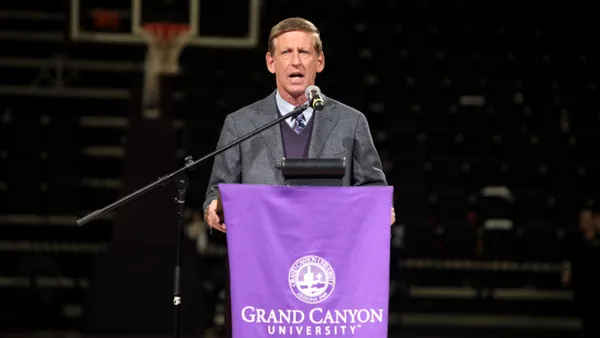Dive Brief:
- The number of international students at U.S. colleges fell 15% in the 2020-21 academic year, plummeting to around 914,000, according to the annual Open Doors report from the Institute of International Education and the U.S. Department of State's Bureau of Educational and Cultural Affairs.
- The declines were driven by decreases in the number of new international students, which fell by 45.6%. The data includes international students studying at U.S. colleges while in the country and from abroad while online, as well as those participating in Optional Practical Training, or OPT, which allows student visa holders to work temporarily in their field of study.
- However, an IIE survey of more than 860 schools found those numbers may be rebounding. They reported that total international enrollment rose 4% this fall while new international enrollment increased 68%.
Dive Insight:
The drop marks the single largest decline since IIE began tracking such data more than seven decades ago. Enrollments from China, India and South Korea — which together account for more than half of international students at U.S. colleges — all declined by more than 13%.
Total international students declined 15% in 2020-21
These drops likely dealt a major blow to the many U.S. colleges that depend on international students for tuition revenue and the global perspective they bring to the classroom.
Undergraduate enrollment fell overall by 14.2%, while graduate enrollment dropped by 12.1%. Students enrolled in nondegree programs declined the most on a percentage basis, by a whopping 63.7%. Meanwhile, students in OPT dipped 8.8%.
Despite the dismal numbers, IIE officials had an optimistic outlook.
"U.S. colleges and universities remained open and welcoming in face of COVID-19 challenges and are well prepared for what's ahead," IIE CEO Allan Goodman said in a statement. "The Open Doors 2021 report gives us all a benchmark to gauge the progress we are making to recover from the COVID-19 pandemic."
Moreover, a survey assessing international student enrollment patterns in the fall of 2021 suggests the numbers are turning around. Seven in 10 polled institutions reported an increase in international student enrollment, 10% said their figures were level and 20% reported a decrease.
Nearly all responding institutions said they were holding face-to-face classes or using a hybrid model. And around two-thirds said international students are studying on their U.S. campuses.
More than half of U.S. colleges said they're prioritizing student outreach in India and China. To do so, majorities of institutions said they're using current international students, hosting online recruitment events and reaching out via social media.
The aftershocks of last year's decline were felt beyond college campuses. International students at U.S. colleges contributed $28.4 billion to the nation's economy during the 2020-21 academic year, a drop of nearly 27% from the year before, according to an analysis from NAFSA: Association of International Educators.
That represents the largest single-year drop recorded since the association began tracking the economic contributions of international students more than two decades ago. NAFSA uses Open Doors data as part of its calculations.
The pandemic and the way it limited international students' travel drove the decrease, NAFSA concluded. Of the roughly $10.3 billion drop seen in the 2020-21 academic year, $9.4 billion is solely due to the health crisis.
"Given the severe impact of the COVID-19 pandemic on international academic mobility, this significant drop in economic activity is not surprising, yet it need not be a trend that we are resigned to seeing continue," NAFSA Executive Director and CEO Esther Brimmer said in a statement.
Brimmer urged the Biden administration to adopt a national strategy to help restore international student enrollment in the U.S.
"We know that U.S. colleges and universities are working tirelessly to support international students in a safe and effective manner during this challenging time," Brimmer said. "Their efforts would be greatly assisted by a coordinated governmental approach that both attracts and retains international talent."













